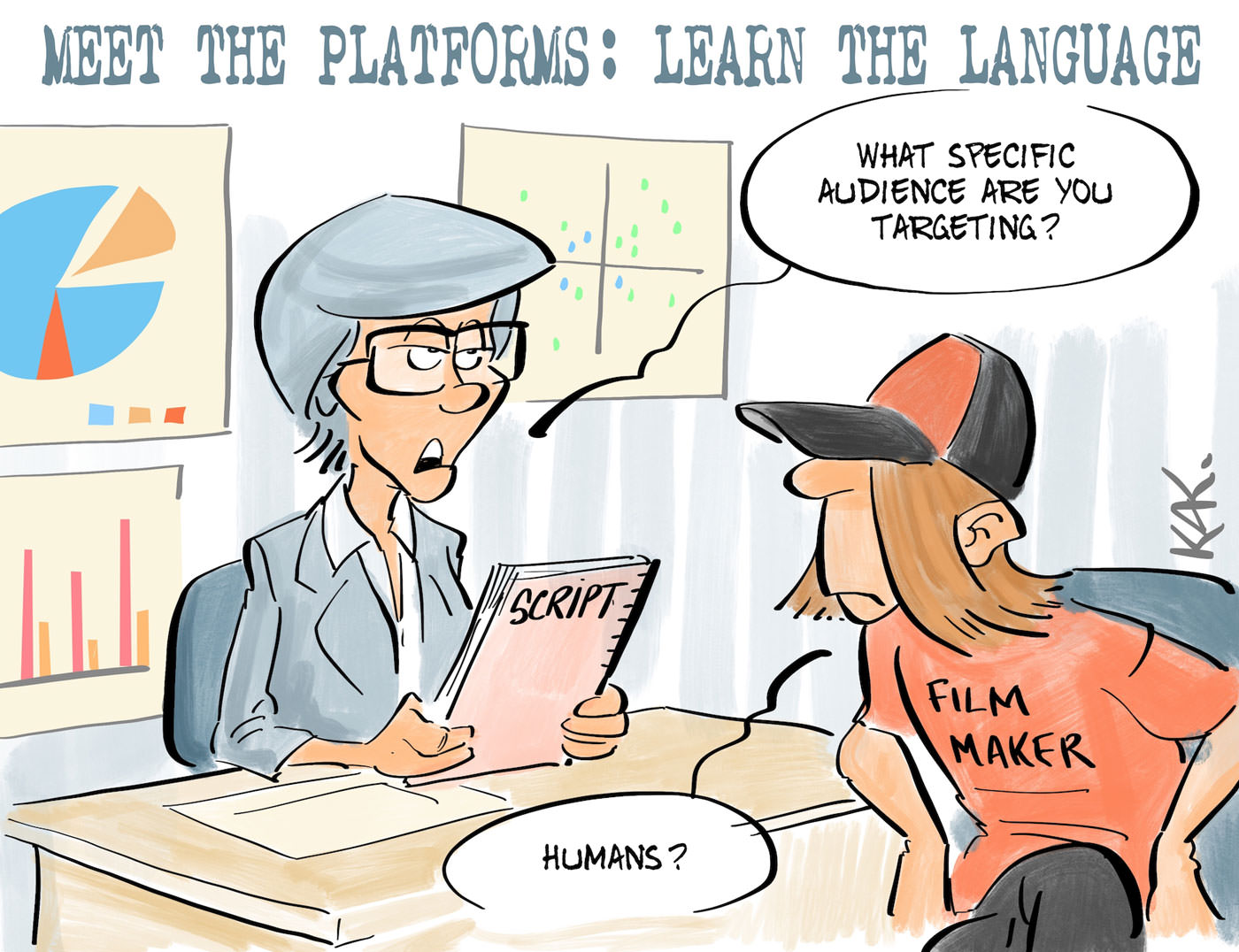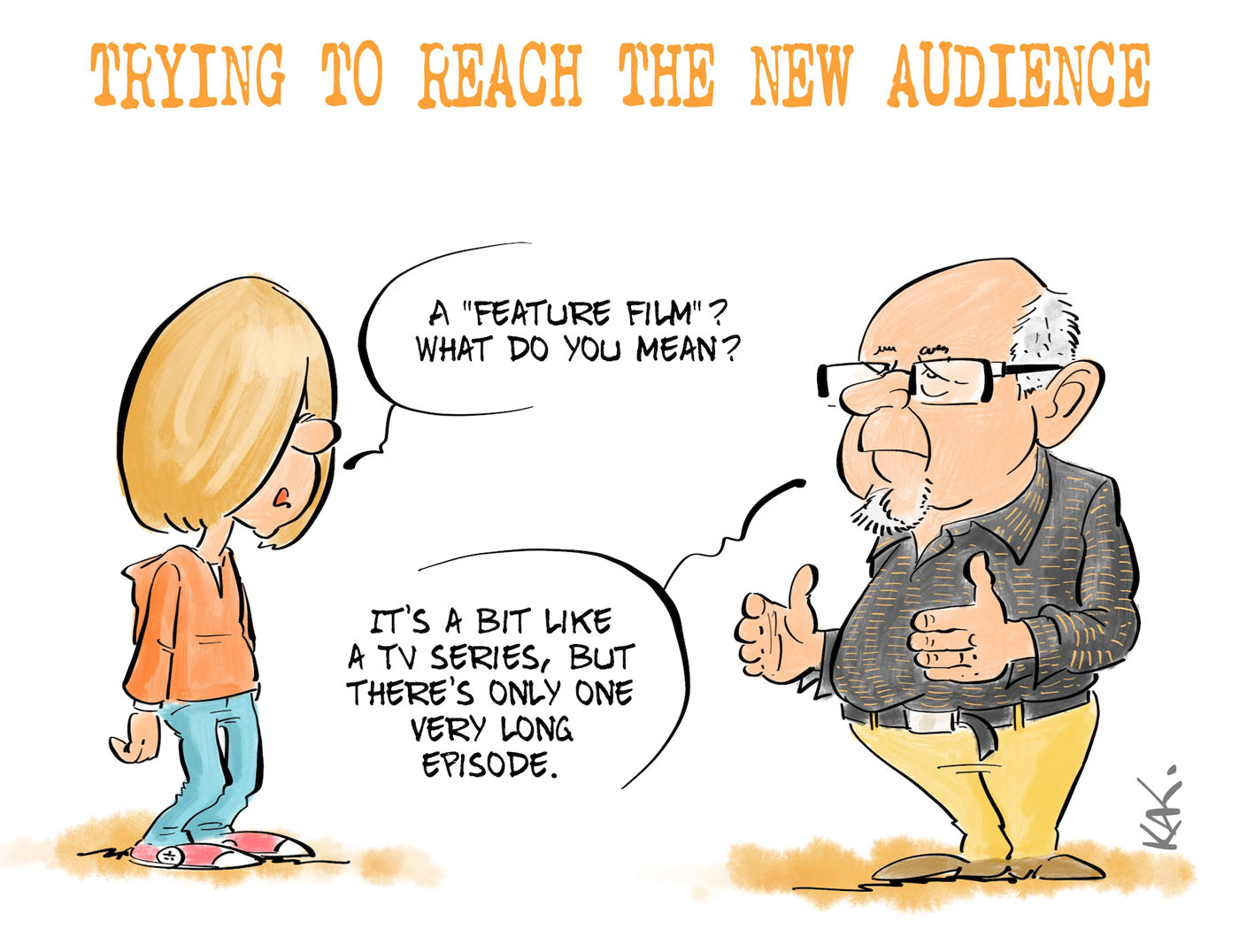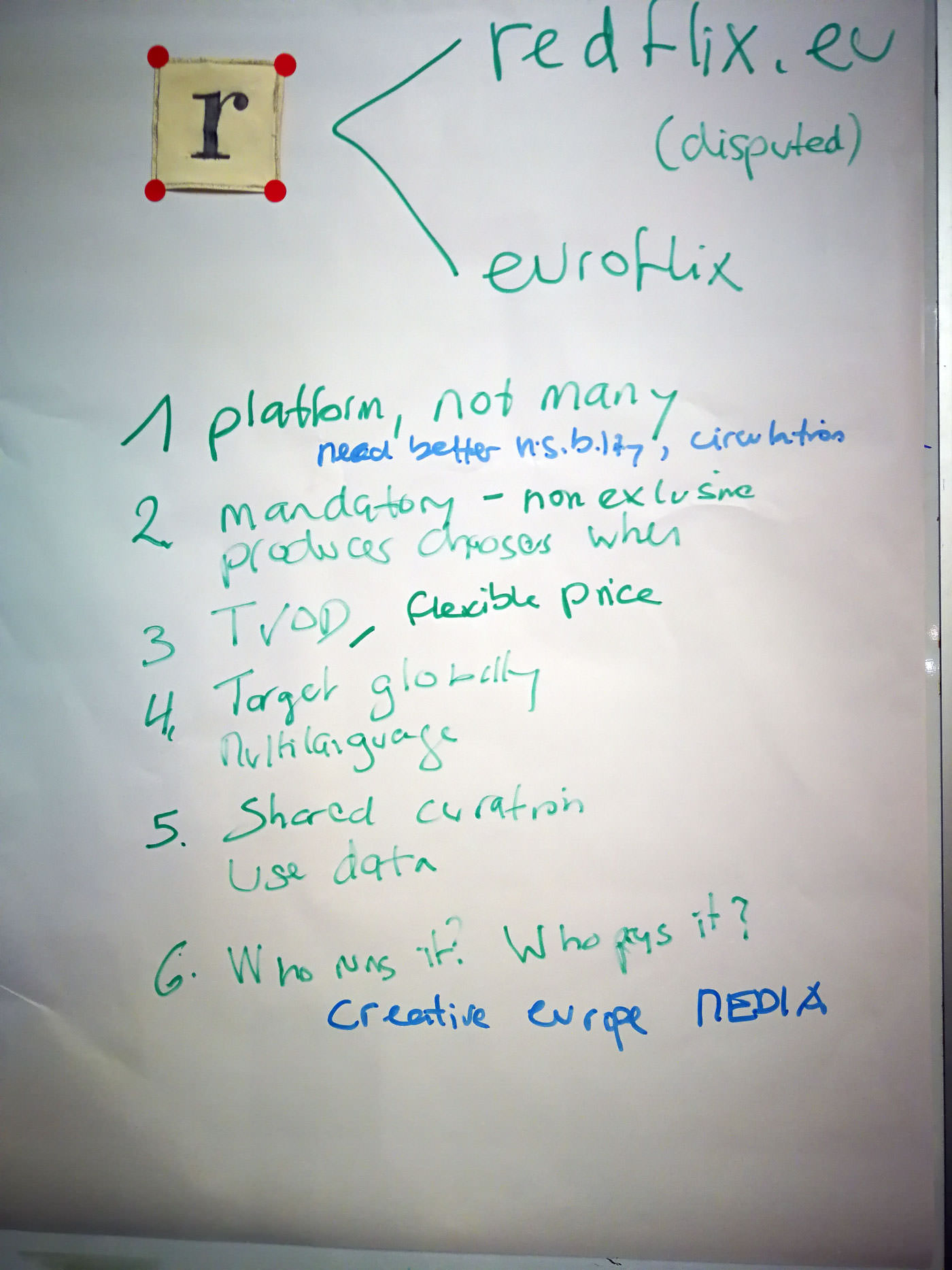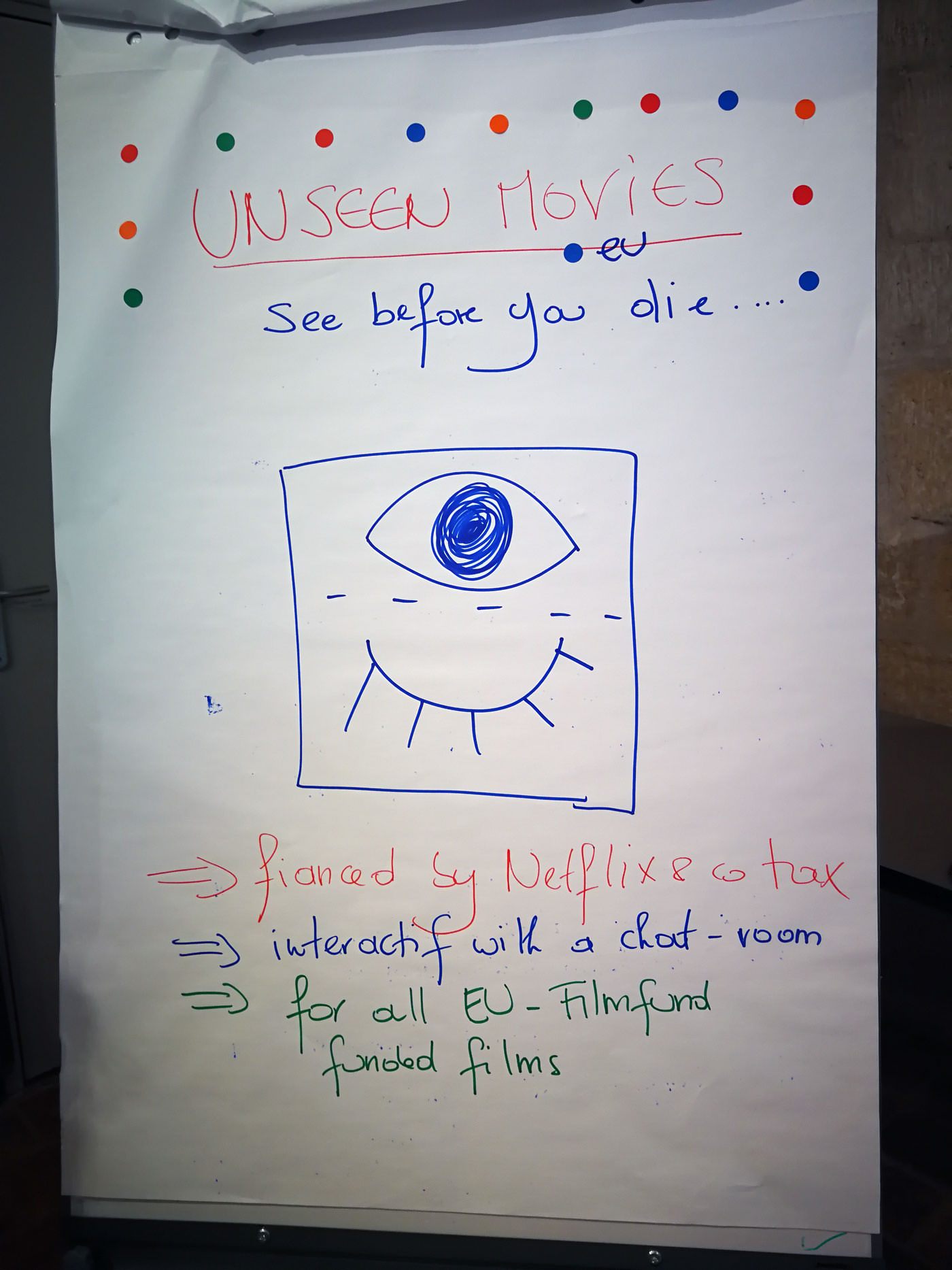Reports Previous Workshops
Eighth Workshop – 26 to 28 September 201, Royaumont Abbey, France
Module 3 – How could funds help each other to make the projects they co-finance visible?
Introduction
A certain number of films funded by public bodies are very briefly distributed on the local or international markets if at all. The main reason for this is not by default the quality of the films, but the competitive markets and the difficulty to find an adequate platform.
In other words:
- Are there some examples of successful strategies?
- Are there some distribution concepts that could be proposed to funds and/or producers/distributors?
- What role could online platforms (VODs, SVODs, etc.) play in this scenario?
- The ecosystem has changed. How do people of different age use media in their everyday life?
Struggle for Visibility and Impact
Impulse speaker: Raimo Lang (YLE/Creative Content division product development for VOD, AOD, TV, radio and on-line)
Please also see Raimo Lang’s presentation (PDF)
The mentality within funding institutions has been constantly changing throughout decades due to technological changes. In the past there was a strong mentality that the “theater is the queen”, which was disrupted by the emergence of the TV channels when the mentality changed to “content is the queen”. When the audience started fragmenting after the emergence of the Internet, the mentality transformed into “user/audience is the queen”. However, in order to succeed in all these aspects and provide impact on society with the produced content, the funds should pursue “the user context is the queen” mentality. This module will explore this mentality as it was applied by the Finnish public broadcaster (YLE) and how it can inspire public film funds.
Threats to Public Broadcasters
The former threat: Classic commercial television channels. Their business models and strategies are, however, predictable today because they rely only on historical data and copy the models have already proven successful.
The current threats:
- The big catalogue companies such as Netflix, HBO, Amazon, Viaplay, etc. continue to grow. They create big turn-over and seem to have endless resources of drama, popular music, and documentaries.
- At the same time, big social platforms like Youtube, Facebook, Instagram, Snapchat are starting to act like commercial broadcasters as well. They are commissioning original fictional and factual content. Youtube will soon start to fund more expensive productions, FB will concentrate on mid-form (5-15 minutes) and long-play videos in order to get advertising embedded (drama, entertainment, docs, etc.). Instagram will invest in IG TV and start to produce and publish videos.
This means that many small, independent production companies are turning directly towards big platforms bypassing broadcasters and film funds. This is in particular worrying, public broadcasters in countries of small language regions as more and more commissioned series eventually end up on Netflix.
The three battles for audience…
- Keeping the 60+ audiences by fighting against other channels. This is the least difficult battle because everybody knows how to fight it.
- Keeping the 35/45+ audiences by competing against catalogue producers. The question is who will have the best drama - global digital platforms or public broadcasters?
- Attracting the 15+ audiences while competing with catalogue producers and fighting for social media visibility.

Challenges
- To reach the new generations, public funders need to buy marketing time on Instagram or Facebook, which costs a lot of money and is problematic because it means giving public money to the direct competitors and non-European companies.
- The audience between 15-29 is the most problematic. In Finland, they constitute 20% of the entire population. But the YLE currently reaches only 20% of them, meaning that remaining 80% do not consume the YLE’s content. Young people are still more interested in Facebook, Youtube, Instagram and Netflix than in the VoD platforms launched by public broadcasters. They do not only want to be entertained, but also to get more complex quality content.
- Engaging young users cannot be done anymore with the linear drama, even the high-quality content released on VoD. The content needs to be accompanied by a strong social media presence and fandoms, which public broadcasters are only now beginnging to address.

- Public broadcasters should not co-produce too much with big platforms or sell to them their content.
YLE’s Success Case Studies
“Mental” – Mission project 2016
Starting point. Mental is a drama series produced in 2016 for the young audience. The starting point in developing the concept was to find and look into a social phenomenon that may attract a wide audience. Thus, YLE conducted a social research on the increasing number of young people with mental problem because it felt like there was something going on there, that nobody talked about. It turned out that every fifth young person suffers from mental problems, and 70% of those people are hiding their problem to avoid shame. In addition, young people do not know where and how to get professional help. In other worlds, the research indicated that this was a relevant social phenomenon, thus YLE decided to deal with it by producing respective content.
The content-creators basically followed a model invented by Netflix. Netflix also looks into social phenomena and finds things that are interesting and relevant for a wider audience. Then they commission a writer or show runner to create a series around that issue.
Goals: YLE defined its goals in regards to this series in a way that would not be measured in numbers, but by social relevance. The goals were:
- to transform the social issue into an everyday matter: “it is ok not to be ok”
- to wipe out shame: “you are not the only one – and not alone”
- to increase the knowledge on the issue: “help is available”
The user-engagement strategy: Mental demonstrated how a drama series, if carefully planned and published, creates an audience engagement in the form of a snowball effect reaching the audiences and different peer-groups on multiple platforms.
Youtube
Writers wrote the scripts after many interviews with young people suffering from mental problems. To make the content visible, the first step was collaboration with one of the most famous rap-singers in Finland. He made a video on set during shooting together with the actors. The video was published one month before the release of the series. It was just a music video of him with the actors before anyone knew about the drama project. It resulted in 100,000 Youtube views in a couple of weeks,, which is 10% of the total young Finnish population.
Then some of the characters from the video started to post on Instagram with the additional insights into the issues covered in the series.
VoD Release
YLE published the the full series on a Friday evening in early May 2016. The first episode got 100,000 views within the first 24 hours. The entire series got several hundreds thousand views within the first weekend. Next Monday, YLE implemented a project with the most famous Finnish Youtube stars, each having 50.000-100.000 subscribers. They were asked to state their experience with or opinion on mental illness. This they did for free although they normally ask for a lot of money for promoting something. Not only did they thus promote the series, they also prompted a lot of discussions and 650.000 social media interactions.
Traditional Marketing
The traditional marketing included interviewing actors and writers and to ensure additional publicity for the series.
Cross-Sectoral Collaboration
The YLE made a deal with relevant professional organizations involved in dealing with mental illnesses and arranged a one-week-long 24/7 chat on the issue aggregating the hotlines of all the organizations. The chat was so successful that a private donor gave money for that 24/7 hotline to be established on a continuous basis.
“Alina Ja Travels to East”
In this case the content-creators designed 20-30 instagram posts and circulated them among representatives of the target audience for a reality check before they were published. Those representatives were aged 17 tp 25 and divided into two groups. They were extremely critical, but there were also things that they liked. Then, the content-creators used paper slips in one color to mark VoD episodes and paper slips in another color to mark Instagram posts. These were shown to the same people and they were asked to propose a publishing rhythm to fit their daily routine, media usage and habits. They did this easily within 15 seconds. For the indie companies producing the content, this provided them with very valuable information on publication.
The lessons that public film funds can learn from public broadcasters
Relying on the experiences of public broadcasters, film funds may reach new audiences in the following ways:
- …by finding new filmic formats (short formats made by new talents, VR, AI content relevant for young audiences)
- …by developing a pan-European VoD platform. Make one supranational platform instead of countless national ones. That is the way to fight Netflix.
- …by funding visibility campaigns and that have social impact. Young generations still idealistically believe they can change the world, and like the content that engages with them in that way. This can be learned from documentary filmmakers.
- …co-operation regarding the rights. Big platforms tend to buy all the rights and annihilate the rights of the public European funders. This could be avoided by giving special rights to the financers from the public sector who will take care that the content is always published in the way that suits them. Selling films (with all their rights) to global US platforms can be a quick and lucrative solution for individual producers, but, at the same time, it is very dangerous for the sector of public film financing in Europe.
The outcomes of the open discussion
The MEDICI participants reached the following conclusions regarding the threats and possibilities coming from the US platforms:
- European public film funds do not want Netflix to finance local productions because Netflix buys the whole IP. However, there are some other buyers in the US that are ready to invest money into European content under more favorable conditions than Netflix. So European producers can try to offer them European productions suitable for the US market, and retain the IP at the same time. European public funds could negotiate on behalf of the European producers to make sure that the IP stays within European national territories. The US investment can be thus combined with the European public funding, which would strengthen the net income for the production company. Also, a US market release raises projects from European countries into the global competition.

- Public funds and broadcasters should be platform neutral. They should encourage producers to approach them with a clear social media strategy and multi-platform release strategy.
- According to the business model in Europe, many producers most often live on the producers’ fees calculated in the production budgets. The revenues generated by the film’s exploitation are economically not as relevant. Therefore, once one film is finished, the producer will rush off to make another film to ensure his/her livelihood. And unless someone comes knocking on their door to offer a lucrative theatrical release they cannot be blamed if they sell the film to Netflix or a similar platform for whatever amount they propose. The financing ecosystem in Europe thus allows platforms to cherry-pick what they want in Europe and it does not yet really affect the market, because many films would be lost anyway.
- At the moment Europe lacks adequate regulations vis-à-vis the US platforms. In the past, every form of exploitation of audiovisual works was regulated. When television came, or VHS or DVD, everything was quickly regulated. But it did not happen after the emergence of the Internet. Today, there are no boundaries. Territoriality is going down the drain. Considering that the platforms are based in another country, the national regulations do not apply to them. That creates a jungle without rules where producers are left to their own devices and they are give away their rights too easily. However, if public film funds are courageous enough to frame negotiations by saying that they will not sell the ownership, but only the license for a certain period and only for the US market, producers would be sheltered. Producers themselves have no capacity to negotiate on that level with big platforms. They are only interested in producing their next film to pay out wages. Europe produces twice as many films as the US. The US digital platforms see Europe as an open bar. They pick the European films they like and buy them only under their own terms and conditions.
- The European ecosystem secures a lot of incentives for production and, to some extent development, but distribution is not enough in the focus. The issues with regulations are not anymore a national debate. It is becoming a supranational issue because the US platforms operate globally.
- European producers more and more engage in the distribution as well. They often have to take a big risk on their fees and overheads to close the financing and thus become dependent on films capacity to make some revenues.
- The ecosystem is changing so quickly due to people’s new media habits. Public funds have to change the know-how they have. It is not valid any more. The structures and habits they have need to be re-thought. On the other, there is still an audience that behaves according to the old ecosystem, which forces the public funders to function on several tracks.
- There are also an increasing number of court-cases regarding the sales of European content to US platforms because those platforms normally refuse to give IPs back when they breach a contract.
- We still have not seen Amazon grow. They are a bigger company than Netflix. Also, Facebook and Google are aggressively entering into creation of entertainment content. Facebook has 1.7 billion subscribers. If they charge people only 2 USD for their original entertainment content, they will earn a lot of money and will be able to finance new films with a lot of money that no one else can afford. They are creating a new bubble and a new ecosystem.
- Regulators need to be as creative as the artists. Now the regulations apply only in the places where the companies are established. Germany is already taxing companies not only according to the establishment’s locations, but also according to whom the company sells its service too. The same is happening in France. Of course, Netflix is suing them now, but this can still be a solution.
- In the past, it was a producer who produces content and publisher who puts it on the market. Today there is verticalization. Distributors are also producers.
Group Exercise
The MEDICI participants, divided into groups, discussed whether film funds should demand that producer enclose strategies for providing visibility for their projects that would prevent a complete dependence on selling films to global digital platforms. Each group could choose one of the following three tasks:
- Design an incentive that will enable producers to do audience outreach, to create an ecosystem and social media to create audience around the content they are creating, to think where they can find audience and how they can address them
- Design a pan-European VoD platform for films supported by public funds, but including media engagement. It should not be only a mediateque, it should also have social media functions.
- Have a discussion and come up with a scheme to protect IPs in the territories where film was publically funded and enable the contact with international platforms at the same time.
The outcome of the group exercise
Group 1:
Most of the funds already have distribution support schemes. We can already include there the financing of any audience-related ideas producers and distributors may come up with. However, the distribution support is coming too late – just before the film is going to be released (few months before). The idea is to include some funds in the production budget that producers can use in this phase to attract future audience, especially through social media. But the issue is how long are the social media followers willing to wait for the final product. And should the marketing start already in the development stage for some of the projects? It is a good possibility only if you really know when you are going to make a film. But it is a problem if you start advertising a film and then it is postponed for three years for whatever reason. Crowd funding is probably the only way to attract audience at the very early stage. Maybe funds should incentivize producers’ crowd-funding campaigns. The Finnish fund did so with the film Iron Sky by investing a lot of money in pre-production, part of which producers used for the crowd funding campaign.
Group 2:
Our opinion on impact incentives is that funds should be as open as possible for the ideas and proposals from the market. The money for promotion and distribution should be open to producers, distributors, exhibitors and all other parties who have good ideas about how to exploit films in cinemas and elsewhere. The funds must also be open for all release windows and for completely new models of marketing. There must not only be a closed set of qualified costs. Funds need to accept new ideas and costs.
Group 3: “Euro-Flix”
There are examples of many VoD platforms (more than 500) supported by Creative Europe. But we would go for one single platform that would work both nationally and globally, and be called, for example, “EuroFlix”. We imagine it as a transactional VoD with a very flexible price-system. It would be a multi-language platform. Its content would be marketed differently in every country in line with the local culture. However, marketing should involve social media in any case.
The public film funds would make it a mandatory requirement that every film must be delivered to this platform. A producer can choose himself when he wants his film to be released on that platform.
The funds should not be running this VoD platform directly because we funded the films ourselves. We need a different player for that. Maybe the European Creative Europe – MEDIA should be turned into this. The platform-generated revenues should be directed towards producers, but funds should invest in the platform as much as possible because VoD platforms are normally expensive (multinational, multi-language releases, subtitling).

Group 4: “EU-Flix “
Our pan-European VoD platform would be called “EU-flix” and would insist on audience engagement via social media. We have two ideas about how this platform could be built. One option is to team up with public broadcasters across the European countries and together create a new channel for consumption of our content. Rather than creating a new system, let’s recreate the old one.
The second plan is to buy Netflix. It could be cheaper than establishing a brand new global platform.
Group 5: “Unseen-Movies.eu/see before you die”
The name of our platform would be “unseen-movies.eu/see before you die”. We imagine this platform to be an alternative to Netflix that would target art-house audience that are very old. Considering that they will soon be too old to move and go to cinema theaters, they will have the films available on our platform. The platform will be funded through taxes collected from Netflix. Public film funds across Europe will force all supported producers to put their films on this platform after 1-2 years of exploitation.
This platform would also introduce editorialisation that Netflix is actually missing. Netflix uses only algorithms to make suggestions for further watching, but our platform would provide presentations of films by famous filmmakers and other influencers. It will also provide interactions within the chat rooms, which is also something that does not exist on the US platforms.

Cooperation between public funds in an increasingly complex and international environment: opportunities, actions, ideas
- Introduction
- Module 1a – Panel: Co-operation between funds means mainly supporting co-production
- Module 1b – Are there possible alternatives?
- Module 2 – How to access smart data to better reach the audience?
- Module 3 – How could funds help each other to make the projects they co-finance visible?
- Module 4a – How to simplify and make life easier for funds and producers in terms of paperwork.
- Module 4b – Digitizing the Funding Process
- Module 5 – How to assess the performance of funding programs dedicated to international co-operation?
Illustrations by KAK
Schedules Previous Workshops Partners Contact